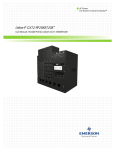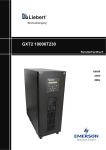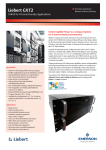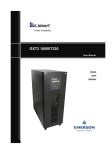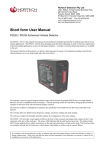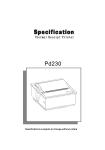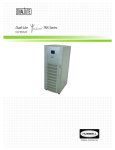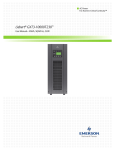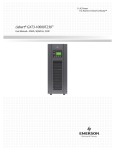Download Liebert® GXT2
Transcript
AC Power For Business-Critical Continuity™ Liebert® GXT2-PP20KRT230™ User Manual–Parallel POD for Liebert GXT2-10000T230 or Liebert GXT2-10000R230 TABLE OF CONTENTS IMPORTANT SAFETY INSTRUCTIONS . . . . . . . . . . . . . . . . . . . . . . . . . . . . . . . . . . . . . . . . . . . . . . . .1 SAVE THESE INSTRUCTIONS . . . . . . . . . . . . . . . . . . . . . . . . . . . . . . . . . . . . . . . . . . . . . . . . . . . . .1 GLOSSARY OF SYMBOLS . . . . . . . . . . . . . . . . . . . . . . . . . . . . . . . . . . . . . . . . . . . . . . . . . . . . . . . .2 1.0 INTRODUCTION . . . . . . . . . . . . . . . . . . . . . . . . . . . . . . . . . . . . . . . . . . . . . . . . . . . . . . . . . .3 2.0 SYSTEM DESCRIPTION . . . . . . . . . . . . . . . . . . . . . . . . . . . . . . . . . . . . . . . . . . . . . . . . . . . .4 2.1 Compatibility . . . . . . . . . . . . . . . . . . . . . . . . . . . . . . . . . . . . . . . . . . . . . . . . . . . . . . . . . . . . . . . 4 2.2 Redundancy Design . . . . . . . . . . . . . . . . . . . . . . . . . . . . . . . . . . . . . . . . . . . . . . . . . . . . . . . . . . 4 2.3 Maintenance Bypass . . . . . . . . . . . . . . . . . . . . . . . . . . . . . . . . . . . . . . . . . . . . . . . . . . . . . . . . . 4 2.4 Liebert MultiLink™ Shutdown . . . . . . . . . . . . . . . . . . . . . . . . . . . . . . . . . . . . . . . . . . . . . . . . . 5 3.0 MAJOR COMPONENTS . . . . . . . . . . . . . . . . . . . . . . . . . . . . . . . . . . . . . . . . . . . . . . . . . . . .7 3.1 Input and Output Slots for UPS . . . . . . . . . . . . . . . . . . . . . . . . . . . . . . . . . . . . . . . . . . . . . . . . 7 3.2 Main Input / Output Terminal Blocks. . . . . . . . . . . . . . . . . . . . . . . . . . . . . . . . . . . . . . . . . . . . 7 3.3 Maintenance Bypass Breaker . . . . . . . . . . . . . . . . . . . . . . . . . . . . . . . . . . . . . . . . . . . . . . . . . . 7 3.4 UPS Input / Output Circuit Breakers . . . . . . . . . . . . . . . . . . . . . . . . . . . . . . . . . . . . . . . . . . . . 8 3.5 Parallel Communication Port . . . . . . . . . . . . . . . . . . . . . . . . . . . . . . . . . . . . . . . . . . . . . . . . . . 8 3.6 Optional Power Distribution . . . . . . . . . . . . . . . . . . . . . . . . . . . . . . . . . . . . . . . . . . . . . . . . . . . 8 4.0 WHAT’S INCLUDED . . . . . . . . . . . . . . . . . . . . . . . . . . . . . . . . . . . . . . . . . . . . . . . . . . . . . . .9 4.1 What You Need. . . . . . . . . . . . . . . . . . . . . . . . . . . . . . . . . . . . . . . . . . . . . . . . . . . . . . . . . . . . . 10 5.0 INSTALLATION . . . . . . . . . . . . . . . . . . . . . . . . . . . . . . . . . . . . . . . . . . . . . . . . . . . . . . . . . 11 5.1 Mount the Liebert GXT2-PP20KRT230 in a Rack or on a Wall . . . . . . . . . . . . . . . . . . . . . . 11 5.1.1 5.1.2 Mount the Liebert GXT2-PP20KRT230 in a Rack . . . . . . . . . . . . . . . . . . . . . . . . . . . . . . . . . . 11 Mount the Liebert GXT2-PP20KRT230 on a Wall . . . . . . . . . . . . . . . . . . . . . . . . . . . . . . . . . . 12 5.2 Paralleling System Connections . . . . . . . . . . . . . . . . . . . . . . . . . . . . . . . . . . . . . . . . . . . . . . . 12 5.3 Main Input and Output Terminal Block Connections . . . . . . . . . . . . . . . . . . . . . . . . . . . . . . 15 5.4 Add an Output Power Distribution Module—Optional . . . . . . . . . . . . . . . . . . . . . . . . . . . . . 16 5.5 Parallel POD Main Electrical Connection—Must Be Installed . . . . . . . . . . . . . . . . . . . . . . . 17 6.0 INITIAL STARTUP AND ELECTRICAL CHECKS . . . . . . . . . . . . . . . . . . . . . . . . . . . . . . . . . . . 18 7.0 CONFIGURATION . . . . . . . . . . . . . . . . . . . . . . . . . . . . . . . . . . . . . . . . . . . . . . . . . . . . . . . .19 7.1 Paralleling for Capacity . . . . . . . . . . . . . . . . . . . . . . . . . . . . . . . . . . . . . . . . . . . . . . . . . . . . . . 19 7.2 Paralleling for Capacity and Redundancy . . . . . . . . . . . . . . . . . . . . . . . . . . . . . . . . . . . . . . . 19 8.0 OPERATION . . . . . . . . . . . . . . . . . . . . . . . . . . . . . . . . . . . . . . . . . . . . . . . . . . . . . . . . . . .20 8.1 Operating Modes . . . . . . . . . . . . . . . . . . . . . . . . . . . . . . . . . . . . . . . . . . . . . . . . . . . . . . . . . . . 20 8.1.1 8.1.2 8.1.3 8.2 Online Mode . . . . . . . . . . . . . . . . . . . . . . . . . . . . . . . . . . . . . . . . . . . . . . . . . . . . . . . . . . . . . . . . 20 Bypass Mode . . . . . . . . . . . . . . . . . . . . . . . . . . . . . . . . . . . . . . . . . . . . . . . . . . . . . . . . . . . . . . . . 21 Output Off Mode. . . . . . . . . . . . . . . . . . . . . . . . . . . . . . . . . . . . . . . . . . . . . . . . . . . . . . . . . . . . . 22 Fault Condition. . . . . . . . . . . . . . . . . . . . . . . . . . . . . . . . . . . . . . . . . . . . . . . . . . . . . . . . . . . . . 23 i 8.3 Battery Test . . . . . . . . . . . . . . . . . . . . . . . . . . . . . . . . . . . . . . . . . . . . . . . . . . . . . . . . . . . . . . . 23 8.4 Disconnect Parallel Communication Cable. . . . . . . . . . . . . . . . . . . . . . . . . . . . . . . . . . . . . . . 23 8.5 Add a Single UPS to the Online Paralleling System . . . . . . . . . . . . . . . . . . . . . . . . . . . . . . . 24 8.6 Remove a Single UPS from the Paralleling System . . . . . . . . . . . . . . . . . . . . . . . . . . . . . . . . 24 8.7 Replacing the Internal Battery—GXT2-10000T230 Only . . . . . . . . . . . . . . . . . . . . . . . . . . . 25 8.8 Replacing the External Battery—GXT2-10000R230 Only. . . . . . . . . . . . . . . . . . . . . . . . . . . 26 8.9 Overload Condition. . . . . . . . . . . . . . . . . . . . . . . . . . . . . . . . . . . . . . . . . . . . . . . . . . . . . . . . . . 26 8.10 Battery Low Voltage—Battery Mode . . . . . . . . . . . . . . . . . . . . . . . . . . . . . . . . . . . . . . . . . . . 27 9.0 COMMUNICATION . . . . . . . . . . . . . . . . . . . . . . . . . . . . . . . . . . . . . . . . . . . . . . . . . . . . . . . 28 9.1 Communications Interface . . . . . . . . . . . . . . . . . . . . . . . . . . . . . . . . . . . . . . . . . . . . . . . . . . . . 28 9.2 UPS Status Information. . . . . . . . . . . . . . . . . . . . . . . . . . . . . . . . . . . . . . . . . . . . . . . . . . . . . . 28 9.3 UPS Configuration Settings . . . . . . . . . . . . . . . . . . . . . . . . . . . . . . . . . . . . . . . . . . . . . . . . . . 29 10.0 SPECIFICATIONS . . . . . . . . . . . . . . . . . . . . . . . . . . . . . . . . . . . . . . . . . . . . . . . . . . . . . . . .30 FIGURES Figure 1 Figure 2 Figure 3 Figure 4 Figure 5 Figure 6 Figure 7 Figure 8 Figure 9 Figure 10 Figure 11 Figure 12 Figure 13 Figure 14 Figure 15 Figure 16 Figure 17 Figure 18 Figure 19 Paralleling system block diagram . . . . . . . . . . . . . . . . . . . . . . . . . . . . . . . . . . . . . . . . . . . . . . . . . . . 4 Liebert MultiLink connection diagram for parallel POD . . . . . . . . . . . . . . . . . . . . . . . . . . . . . . . . . 5 Configure Liebert MultiLink 1.5 for shutdown to work with a parallel system . . . . . . . . . . . . . . . 6 Liebert GXT2-PP20KRT230 components . . . . . . . . . . . . . . . . . . . . . . . . . . . . . . . . . . . . . . . . . . . . . 7 Optional output distribution module—PD230-101 . . . . . . . . . . . . . . . . . . . . . . . . . . . . . . . . . . . . . . 8 Items shipped with Liebert GXT2-PP20KRT230 . . . . . . . . . . . . . . . . . . . . . . . . . . . . . . . . . . . . . . . 9 Components of Liebert GXT2-20K230PC-2 or Liebert GXT2-20K230PC-4 . . . . . . . . . . . . . . . . . . 9 Secure the fixed brackets to the Liebert GXT2-PP20KRT230 . . . . . . . . . . . . . . . . . . . . . . . . . . . . 11 Secure a parallel POD to a rack . . . . . . . . . . . . . . . . . . . . . . . . . . . . . . . . . . . . . . . . . . . . . . . . . . . . 11 Mount the Liebert GXT2-PP20KRT230 on a wall. . . . . . . . . . . . . . . . . . . . . . . . . . . . . . . . . . . . . . 12 GXT2-10000R230 Ground Connection. . . . . . . . . . . . . . . . . . . . . . . . . . . . . . . . . . . . . . . . . . . . . . . 14 GXT2-10000T230 Ground Connection . . . . . . . . . . . . . . . . . . . . . . . . . . . . . . . . . . . . . . . . . . . . . . . 14 GXT2-PP20KR230 Ground Connection . . . . . . . . . . . . . . . . . . . . . . . . . . . . . . . . . . . . . . . . . . . . . . 15 Hardwire terminal connections . . . . . . . . . . . . . . . . . . . . . . . . . . . . . . . . . . . . . . . . . . . . . . . . . . . . 15 Secure the cover plate over the terminal connections. . . . . . . . . . . . . . . . . . . . . . . . . . . . . . . . . . . 15 Install the optional output power distribution module on the parallel POD. . . . . . . . . . . . . . . . . 16 100A input circuit breaker connection. . . . . . . . . . . . . . . . . . . . . . . . . . . . . . . . . . . . . . . . . . . . . . . 17 Open the maintenance bypass breaker cover . . . . . . . . . . . . . . . . . . . . . . . . . . . . . . . . . . . . . . . . . 22 Calculating total load per UPS. . . . . . . . . . . . . . . . . . . . . . . . . . . . . . . . . . . . . . . . . . . . . . . . . . . . . 28 TABLES Table 1 Table 2 Table 3 Table 4 Table 5 Table 6 Table 7 Electrical requirements . . . . . . . . . . . . . . . . . . . . . . . . . . . . . . . . . . . . . . . . . . . . . . . . . . . . . . . . . . Maximum output power from paralleled UPSs. . . . . . . . . . . . . . . . . . . . . . . . . . . . . . . . . . . . . . . . Calculating total load, 20kVA example . . . . . . . . . . . . . . . . . . . . . . . . . . . . . . . . . . . . . . . . . . . . . . Calculating total load, 12kVA example . . . . . . . . . . . . . . . . . . . . . . . . . . . . . . . . . . . . . . . . . . . . . . Parallel POD specifications . . . . . . . . . . . . . . . . . . . . . . . . . . . . . . . . . . . . . . . . . . . . . . . . . . . . . . . Paralleling cable kit . . . . . . . . . . . . . . . . . . . . . . . . . . . . . . . . . . . . . . . . . . . . . . . . . . . . . . . . . . . . . Optional output distribution specifications . . . . . . . . . . . . . . . . . . . . . . . . . . . . . . . . . . . . . . . . . . . ii 15 19 29 29 30 30 30 IMPORTANT SAFETY INSTRUCTIONS ! WARNING Risk of electric shock. Can cause equipment damage, injury or death. Extreme caution is required when performing maintenance. Service and maintenance work must be performed only by properly trained and qualified personnel and in accordance with applicable regulations and manufacturers’ specifications. Be constantly aware that the UPS system contains high DC voltages as well as high AC voltages. • Opening or removing the cover may expose personnel to lethal voltages within this unit even when it is apparently not operating and the input wiring is disconnected from the electrical source. • Observe all warnings and cautions in this manual. Failure to do so may result in serious injury or death. • Never work alone. SAVE THESE INSTRUCTIONS This manual contains important safety instructions pertaining to the Liebert GXT2-PP20KRT230™, a parallel power output device that will connect up to three Liebert GXT2-10000T230™ or Liebert GXT2-10000R230™ UPSs. Read all safety, installation and operating instructions before operating the Liebert GXT2-PP20KRT230 parallel power output distribution (parallel POD). Adhere to all warnings on the unit and in this manual. Follow all operating and user instructions. Individuals must fully understand this equipment to install and operate it. It is not intended for use with life support or other designated critical devices. Maximum load must not exceed that shown on the Liebert GXT2-PP20KRT230 rating label. This parallel POD is designed for use on a properly grounded (earthed), 220~240 VAC, 50Hz or 60Hz supply. The factory default setting is 230VAC, 50Hz. Installation instructions and warning notices are found in this manual. This Liebert parallel POD is only for use with a three-wire input: L, N, G. ELECTROMAGNETIC COMPATIBILITY—The Liebert GXT2-PP20KRT230 complies with the standards under Directive 2004/108/EC. Operation is subject to the following two conditions: 1. This device may not cause harmful interference and 2. This device must accept any interference received, including interference that may cause undesired operation. Operating this device in a residential area is likely to cause harmful interference that users must correct at their own expense. Operate the parallel POD in an indoor environment only in an ambient temperature range of 0°C to 40°C (32°F-104°F). Install it in a clean environment, free from conductive contaminants, moisture, flammable liquids, gases and corrosive substances. This parallel POD contains no user serviceable parts. Refer all faults to your local dealer, Liebert representative or the Liebert Worldwide Support Group. Never block or insert any object into the ventilation holes or other openings of the paralleled UPS. DO NOT CONNECT equipment that could overload the parallel POD or demand half-wave rectification from the parallel POD, for example: electric drills, vacuum cleaners, laser printers, hair dryers or any other appliance using half-wave rectification. Storing magnetic media on top of the UPS or parallel POD may result in data loss or corruption. Turn Off the parallel POD and connected UPSs and isolate the paralleling system before cleaning; use only a soft cloth, never liquid or aerosol cleaners. 1 GLOSSARY OF SYMBOLS Risk of electrical shock ! Indicates caution followed by important instructions AC input AC output i - Suggests the user consult the manual + Indicates the unit contains a valve-regulated lead acid battery PbH2SO4 DC voltage Equipment grounding conductor Bonded to ground AC voltage R Recycle WEEE 2 Introduction 1.0 INTRODUCTION Congratulations on your choice of the Liebert GXT2-PP20KRT230 parallel POD. It allows parallel connection of the input and output up to three Liebert GXT2-10000T230™ or Liebert GXT2-10000R230™ UPSs. The Liebert GXT2-PP20KRT230 parallel POD features an N+1 redundancy. While one Liebert GXT2-10000T230 or one Liebert GXT2-10000R230 UPS is available at 10kVA nominal power rating, connecting three units in parallel provides 20kVA of output power, plus the redundancy of one 10kVA UPS. The Liebert GXT2-PP20KRT230 is a compact, parallel POD. A parallel POD continuously provides conditioned power from connected Liebert GXT2-10000T230 or Liebert GXT2-10000R230 UPSs whether mains power is present or not. For ease and safety of installation, the Liebert GXT2-PP20KRT230 is designed with short-circuit protection and color-coded outlets for the UPS electrical connectors. The Liebert GXT2-PP20KRT230 has three parallel ports to communicate with the UPSs. 3 System Description 2.0 SYSTEM DESCRIPTION 2.1 Compatibility The Liebert GXT2-PP20KRT230 parallel POD is compatible only with the Liebert GXT2-10000T230 and the Liebert GXT2-10000R230 UPS. No more than three of the same model of either the Liebert GXT2-10000T230 or Liebert GXT2-10000R230 UPSs can be connected to the parallel POD. 2.2 Redundancy Design During normal operation with parallel connection of three Liebert GXT2-10000T230 or Liebert GXT2-10000R230 UPSs, the parallel POD supplies 20kVA of output power plus redundancy of one 10kVA UPS. With the Liebert GXT2-PP20KRT230 N+1 redundancy design, the failure of one UPS will not affect the functioning of the overall system. 2.3 Maintenance Bypass When the UPS system must be shut down, maintenance bypass allows the parallel POD to operate without interrupting power to the load. As shown in Figure 1, the Liebert GXT2-PP20KRT230 provides an alternate path for mains power to the connected load. The UPS may be switched to Bypass Mode to continue powering the load during UPS maintenance or repair (see 8.1.2 - Bypass Mode for the transfer procedure). Figure 1 Paralleling system block diagram Utility Branch Breaker Terminal Block of POD (Main Input ) Input Breaker Input Breaker Input Breaker UPS1 UPS2 UPS3 Output Breaker Output Breaker Output Breaker Terminal Block of POD (Output ) Optional POD Parallel Signal Board O/P Breaker Load 4 System Description 2.4 Liebert MultiLink™ Shutdown The parallel POD supports the orderly shutdown of computer operating system through its compatibility with Liebert MultiLink 1.5 software. When properly configured to operate with Liebert MultiLink 1.5, the parallel POD will operate as a complete system; On Battery and Low Battery events will not be sent from the UPS when it is operating in redundant mode and the remaining UPS is able to support the total load. For the paralleling system to work properly with Liebert MultiLink 1.5, each connected 10kVA UPS must have an SNMP card properly installed and configured in the Liebert IntelliSlot® bay. Liebert MultiLink 1.5 will not work properly with the parallel system through the serial port connection. Figure 2 Liebert MultiLink connection diagram for parallel POD Computer With Liebert MultiLink Agent Ethernet SNMP UPS 1 SNMP UPS 2 SNMP UPS 3 Parallel Port Parallel Port Parallel Port Parallel Port Liebert GXT2-PP20KRT230 Parallel POD The SNMP card must be properly configured with an IP ADDRESS, NETMASK and GATEWAY. Refer to the SNMP card user manual for detailed instructions. The SNMP card must also be configured with a community string to be monitored by Liebert MultiLink. For details, refer to the Liebert MultiLink 1.5 user manual, SL-53620, available at the Liebert Web site, www.liebert.com Liebert MultiLink 1.5 also must be properly configured for the software shutdown to work properly with the parallel system. Refer to the Liebert MultiLink 1.5 user manual for detailed configuration instructions. Two important settings required for Liebert MultiLink shutdown to work properly are: • The connection option “Liebert UPS (using SNMP port 162)” must be selected, either during installation or later (see Figure 3; refer to the MultiLink 1.5 user manual, SL-53620, for details). • The options “Enable shutdown after an on-battery event” and “Enable shutdown after a low-battery event” must be selected for Liebert MultiLink to initiate shutdown when either of these events occur (see Figure 3; refer to the MultiLink 1.5 user manual, SL-53620, for details). 5 System Description Figure 3 Configure Liebert MultiLink 1.5 for shutdown to work with a parallel system Select this option either while installing the software or later through the connection options Enable shutdown ... ... for these events 6 Major Components 3.0 MAJOR COMPONENTS The Liebert GXT2-PP20KRT230 has five main components (see Figure 4): • • • • • Figure 4 UPS input/output circuit breakers Main input/output terminal blocks Parallel communication ports Maintenance bypass breaker Input and output slots for each UPS Liebert GXT2-PP20KRT230 components Main Input / Output Terminal Blocks UPS3 OUTPUT UPS2 INPUT OFF UPS1 OUTPUT OFF 60 OFF 60 OFF OFF UPS1 INPUT OFF 60 60 OFF OFF OFF OFF UPS2 OFF Maintenance Bypass Breaker UPS Input / Output Circuit Breakers OFF MAIN INPUT UPS2 OUTPUT OFF OFF Parallel Communication Ports Parallel Communication Port UPS1 OUTPUT OFF UPS3 OFF UPS3 INPUT Input and Output Slots for UPS 3.1 Input and Output Slots for UPS The parallel POD is shipped with three input/output slots for hardwire connections with the UPSs. The six-pole connector with color coding and keying are used for the interconnecting wires between UPS input and output. The UPS connector will snap into the connector of the parallel POD only in the correct direction and only with the same color. 3.2 Main Input / Output Terminal Blocks Hardwire terminal blocks are at the top left corner on the front side of the parallel POD. Input and output wiring should not share the same conduit. See the requirements and label in 5.3 - Main Input and Output Terminal Block Connections to connect the wires. 3.3 Maintenance Bypass Breaker The Maintenance Bypass Breaker allows the user to transfer the load to utility to remove a UPS from the paralleling system for maintenance without shutting off power to the load (see 8.1.2 - Bypass Mode for the transfer procedure). For further information on the UPS Maintenance Bypass Breaker, refer to the Liebert GXT2-10000T230 or Liebert GXT2-10000R230 user manual, available on the Liebert Web site: www.liebert.com. NOTE While the maintenance bypass breaker is energized, the connected load is not protected from mains failures, surges and sags. 7 Major Components 3.4 UPS Input / Output Circuit Breakers The Liebert GXT2-PP20KRT230 is equipped with six circuit breakers (three input breakers and three output breakers). During normal operation in the paralleling system, input/output circuit breakers are in the On position. When installing or removing a UPS, switch the corresponding breakers to the Off position. 3.5 Parallel Communication Port The Liebert GXT2-PP20KRT230 parallel POD has three 25-pin parallel communication ports on the right of the parallel POD. Several signals are provided on this port to communicate with each UPS. Use the parallel communication cables for the connection between the parallel POD and each UPS. When the UPS is started, it enters parallel mode automatically. Refer to 5.0 - Installation for the cable connection procedures. NOTICE Do not disconnect the parallel communication cable while the parallel system is operating and powering the connected load. This may cause load-drop and damage the UPS or connected equipment. If the parallel communication cable is disconnected or the connection is dropped during parallel operation, the UPS will shut down immediately. If the parallel communication cable is not connected to the UPS, the UPS will not enter parallel mode, even if the parallel power cable is connected. Operating without the parallel communication cable may result in damage to the UPS. 3.6 Optional Power Distribution Additional power distribution options are available to provide the benefit of output receptacle convenience. See 5.4 - Add an Output Power Distribution Module—Optional for installation steps. Figure 5 Optional output distribution module—PD230-101 Internal Connector 8 What’s Included 4.0 WHAT’S INCLUDED The Liebert GXT2-PP20KRT230 is shipped with: • • • • • • • • • Figure 6 User Manual: 1 Cover Plate for Main Terminal Block: 2 Cover Plate for Parallel Communication Cable Connectors: 1 Edge Guards: 6 M6 Clips: 8 Fixed Rack-Mounting Brackets: 4 Bottom Cover Plate: 1 Key: 2 Screws Items shipped with Liebert GXT2-PP20KRT230 al anu rM Use Edge Guard Fixed Brackets for Rack Mounting Bottom Cover Plate User Manual Clips Screws Cover Plate for Parallel Communication Cable Connectors Cover Plate for Main Terminal Block Key For the paralleling system connection, a Liebert GXT2-20K230PC-2 or Liebert GXT2-20K230PC-4 kit must be purchased separately for each UPS. One pack contains: • Parallel Power Cable: 1 • Parallel Communication Cable: 1 • Cover Plate for Parallel Communication Cable Connector: 1 • Mounting Screws for Cover Plate: 2 • Fixed Plate for Connector: 1 • Cable Clamps and Locknuts: 2 Each • Screws Figure 7 Components of Liebert GXT2-20K230PC-2 or Liebert GXT2-20K230PC-4 I/P G N I/P L P I/ Parallel Communication Cable O/P G N O/P L P O/ Parallel Power Cable Fixed Plates for Connectors Communication Cover Plate and Mounting Screws Cable Clamps and Locknuts NOTE If the parallel POD will be mounted on the wall, the installer must supply the eight wall inserts and eight screws needed to support the parallel POD and cable assembly. 9 What’s Included 4.1 What You Need You will need the following tools to make the parallel system connections: • • • • • • • 10mm slotted screwdriver Phillip #1 screwdriver Phillip #2 screwdriver 10mm hex driver 5mm hex driver 5mm hex wrench Star T10 screwdriver 10 Installation 5.0 INSTALLATION This section includes instructions on how to set up the connections between the parallel POD and the UPS, connect wiring to the terminal block, install the Liebert GXT2-PP20KRT230 parallel POD in a rack or on a wall and add an optional distribution POD. Do NOT attempt to start the UPS, turn on any circuit breaker or energize the input power until instructed to do so in 6.0 - Initial Startup and Electrical Checks. Verify that all circuit breakers are in the open (Off) position. Inspect the parallel POD for freight damage. Report any damage to the carrier and your local dealer or Liebert representative. 5.1 Mount the Liebert GXT2-PP20KRT230 in a Rack or on a Wall The Liebert GXT2-PP20KRT230 may be mounted either in a rack or on a wall. When installing the Liebert GXT2-PP20KRT230, use the factory-supplied fixed brackets (see Figure 8). 5.1.1 Mount the Liebert GXT2-PP20KRT230 in a Rack 1. Position the four fixed brackets at the screw holes—front, middle or rearmost—on either side of the Liebert GXT2-PP20KRT230 that best fit the installation location desired. Figure 8 shows an example of securing the fixed brackets to the front screw holes. 2. Determine an appropriate place for the Liebert GXT2-PP20KRT230 in the rack and secure the fixed brackets to the POD with the included screws (Figure 9). Figure 8 Secure the fixed brackets to the Liebert GXT2-PP20KRT230 OFF OFF 60 Figure 9 OFF 60 OFF 60 60 Secure a parallel POD to a rack OFF OFF 60 11 OFF 60 OFF 60 60 Installation 5.1.2 Mount the Liebert GXT2-PP20KRT230 on a Wall 1. Secure the four fixed brackets to the rearmost screw holes on either side of the Liebert GXT2-PP20KRT230 (see Figure 10). 2. Determine an appropriate place on the wall and secure the fixed brackets of the POD onto it with the included screws. 3. Attach the Liebert GXT2-PP20KRT230 to the wall. Figure 10 Mount the Liebert GXT2-PP20KRT230 on a wall OFF OFF 60 5.2 OFF 60 OFF 60 60 Paralleling System Connections The Liebert GXT2-PP20KRT230 is shipped with the input and output slots for UPS and the optional output power distribution section covered. Installation of the paralleling system requires: parallel power cables, fixed plates and cable clamps. These are included in the Liebert GXT2-20K230PC-4 and the GXT2-20K230PC-2 kits (see 4.0 - What’s Included) for the installation. Follow the procedures below to start the installation. ! WARNING Risk of electric shock. May cause property damage, personal injury or death. Lethal voltages may exist within the UPS and parallel POD as long as the UPS is connected. Ensure that all the UPSs are disconnected and that the power is off before working within the parallel POD. Check the circuits with a voltmeter. In addition, verify that all the internal batteries within the Liebert GXT2-10000R230 and Liebert GXT2-10000T230 units are disconnected. 1. Remove the screws securing the parallel POD covers. Keep the optional output power distribution cover closed when not in use (see 5.4 - Add an Output Power Distribution Module— Optional for the optional POD installation). 2. Connect one end (six-pole connector) of the parallel power cable to the UPS input and output slot on the parallel POD. They are color-coded for proper alignment and installation. 3. Use the fixed plate to tighten the connector securely. 4. Use two cable clamps to fasten the parallel power cable onto the parallel POD (10mm hex driver is required) 12 Installation 1 2 3 4 UPS1 5. Remove the conduit box cover from the rear panel of the UPS. 6. Insert the terminated ends of the power cables through the conduit box entry holes. E 5 INPUT Main 1 Input~ L1 L2 L3 Main 2 Input~ N E 8 6&7 OUTPUT N Ouput~ L N S N O/P G O/P N O/P L I/P G I/P N I/P L N L L N ~ L INPUT N L ~ N N L N L I/P G O/P L I/P N I/P L O/P N O/P G 7. 8. 9. 10. 11. L OUTPUT INPUT OUTPUT N L Connect the input and output cables to the corresponding terminal block on the UPS’ rear panel. Tighten the screws using a 9.5mm slotted screwdriver. Repeat Steps 2 through 8 to connect the other parallel power cables to the other UPSs. Remove the parallel port cover from the rear panel of the UPS. Attach one end of the parallel communication cable to the parallel communication port on the parallel POD, then attach another end to the parallel port on the UPS rear panel. The parallel communication cable and power cable should correspond with numbered port on the parallel POD. For example, if the power cable is connected to the input/output slot labeled “UPS1” on the parallel POD, then the parallel port cable must be connected to PORT 1 on the parallel POD. 12 E 12 E OFF OFF 60 OFF 60 OFF 60 60 OFF OFF 60 N L L OFF 60 OFF 60 60 N 12. Install the cover plates for the parallel communication cable connectors on the parallel POD and each UPS. 13 Installation 14 14 14 OFF OFF 60 OFF 60 OFF 60 60 13. Insert the edge guards into the open slots of the cover plate. 14. Place the bottom cover plate on the parallel POD. 15 16 NOTE If the 4.5m parallel cable is used, it must connect the ground wires to the UPS and parallel POD. Figure 11 GXT2-10000R230 Ground Connection Ground Connection Figure 12 GXT2-10000T230 Ground Connection Ground Connection 14 Installation Figure 13 GXT2-PP20KR230 Ground Connection Ground Connection 5.3 Main Input and Output Terminal Block Connections Conduit entry holes are provided on the front top of the parallel POD. Input and output wiring should be run in separate conduits. See the following requirements and label to connect the wires. Table 1 Electrical requirements Input Current Rating Recommended Maximum External Overcurrent Protection Recommended Wire (including ground wire) (75°C copper wire) Terminal Tightening Torque 100A 92A 16mm2 1/0 AWG 5.6 N-m (50 lb-in) Figure 14 Hardwire terminal connections Green Red Black L N OUTPUT Green L N INPUT SEE INSTALLATION INSTRUCTIONS BEFORE CONNECTING TO THE SUPPLY NOTE Terminal blocks are color-coded for easy installation. Verify that the wires are connected to the correct terminals. A 5mm hex wrench is required for tightening the terminal blocks. When the terminal block connections are done, secure the cover plate with seven screws (see Figure 15). Figure 15 Secure the cover plate over the terminal connections 15 Installation 5.4 Add an Output Power Distribution Module—Optional ! WARNING Risk of electric shock. Can cause equipment damage, injury or death. Lethal voltages may exist within the UPS and parallel POD as long as the UPS is connected. Before beginning to install the optional output distribution module, verify that the paralleling system and all connected UPSs are completely powered off. To add an optional output distribution module to the Liebert GXT2-PP20KRT230: 1. Disconnect and secure mains power from the parallel POD and completely power Off all connected UPSs. 2. Remove the four screws securing the blank output distribution cover plate of the parallel POD. 3. Set the screws aside to attach an output distribution module to the parallel POD. 4. Snap together the color-coded, mating electrical connectors of the optional output distribution module to the parallel POD. 5. Use the screws removed in Step 2 to attach the output distribution module to the rear of the parallel POD Figure 16 Install the optional output power distribution module on the parallel POD. OFF OFF 60 OFF 60 OFF 60 60 Attach Optional Output Power Distribution Module to Parallel Pod OptionaL Output Power Distribution Module 16 Installation 5.5 Parallel POD Main Electrical Connection—Must Be Installed Electrical connections are made through a removable conduit box that attaches to the top of the parallel POD. A breaker is required for short-circuit or overcurrent protection. The installer must provide an external circuit breaker for the input and output of the Parallel POD based on the current ratings below. • Rating: 20kVA • Max Input Current: 100A • Max Output Current: 92A If the paralleling system detects any UPS with short circuit or overcurrent, the input circuit breaker and the output circuit breaker on the rear fixed-panel of the UPS disconnect all power between the main cabinet and the distribution box. The manual bypass breaker passes mains power directly to the output terminal block from the input terminal block.. The three UPS input circuit breakers on the POD do not disconnect power from the manual bypass breaker. Figure 17 100A input circuit breaker connection UPS1 63A Input and Output Circuit Breakers I/P O/P UPS2 I/P O/P UPS3 I/P O/P Optional Output Distribution Module Input Mains Maintenance Breaker 100A External Circuit Breaker Main I/P Terminal Block Output Maximum 92A External Circuit Breaker Load 17 Initial Startup and Electrical Checks 6.0 INITIAL STARTUP AND ELECTRICAL CHECKS This section includes the procedures for installing the paralleling system for the first time and performing initial system checks of each UPS individually before connecting them in parallel. NOTICE Miswiring power to the input terminal block (L-N-G) may damage the UPS. For the initial installation: 1. Verify that the input circuit breakers on UPS are Off (open). (To find the circuit breakers, refer to the UPS user manual .) 2. Verify that the parallel communication cables are disconnected from the parallel ports. 3. Verify that the UPS is completely Off. 4. Connect the parallel POD main input and output wiring to the load equipment. 5. Connect the UPS input power wires to the parallel POD. To start the initial electrical checks for each UPS: 1. Switch On (close) the UPS input and output breakers on the parallel POD of only the first UPS to be checked. 2. Switch On (close) the input circuit breakers on the rear of the UPS. 3. Power On the UPS, and verify that it is operating normally. 4. Verify that the UPS output voltage is correct. If the output voltage of the UPS must be changed with the configuration program, it must be done now. Refer to the UPS user manual for instructions on changing the output voltage. 5. Power Off the UPS, and switch Off (open) the corresponding input and output breakers on the parallel POD and the input breakers of the UPS. 6. Repeat the initial electrical checks on the second and third UPSs to make sure each UPS in the paralleling system is operating normally and set for the same output voltage configuration. 18 Configuration 7.0 CONFIGURATION The Liebert GXT2-PP20KRT230 parallel POD allows connecting a maximum of three UPSs in parallel. See Table 2 for the maximum output power. Table 2 7.1 Maximum output power from paralleled UPSs Method Number of UPSs Maximum Output Power Redundancy Paralleling for Capacity 2 20kVA - Paralleling for Capacity and Redundancy 3 20kVA 10kVA Paralleling for Capacity When two UPSs are connected to the paralleling system, the maximum output power is 20kVA. Each UPS supplies 10kVA of output power. Redundant power is not available if either of the paralleled UPSs fails. 7.2 Paralleling for Capacity and Redundancy When three UPSs are connected to the paralleling system, the maximum output power is 20kVA plus redundancy of one 10kVA UPS. This setup permits the paralleling system to operate normally even if one of the UPSs fails or runs out of battery power. For the paralleling procedures, see 5.0 - Installation. 19 Operation 8.0 OPERATION 8.1 Operating Modes 8.1.1 Online Mode To power on the whole paralleling system: 1. Verify individual UPS operation as detailed in 6.0 - Initial Startup and Electrical Checks. 2. Connect all parallel power cables and parallel communication cables between the UPSs and parallel POD. 3. Switch all output circuit breakers on the parallel POD to the On (closed) position. 4. Switch all input circuit breakers on the parallel POD to the On (closed) position. 5. Switch the input circuit breaker of all connected UPSs to the On (closed) position. Liebert GXT2-10000R230 1. Ensure that all switches and circuit breakers upstream of the UPS are closed. 2. Switch the input breaker to Position I (On). 3. Close any external breakers connecting the load. 4. Press the button on the UPS control panel for a minimum of one second to switch on the inverter (see the Liebert GXT2-10000R230 user manual for more information). These LEDs should be illuminated: AC INPUT, BYPASS and LOAD. 5. After a few seconds the UPS ON LED illuminates and the BYPASS LED goes off. The UPS is now in Online Mode. 6. Perform Step 2 on all UPSs in the paralleling system within one minute. If Step 2 is not performed on all UPSs in the system within one minute, the paralleling system cannot enter Online Mode. Liebert GXT2-10000T230 1. Ensure that all switches and circuit breakers upstream of the UPS are closed. 2. Ensure that the mains connections are secured at the UPS input. Refer to the Liebert GXT2-10000T230 user manual for more information. 3. On the parallel POD, close the output breakers for each UPS attached to the parallel POD. 4. On the parallel POD, close the input breakers for each UPS attached to the parallel POD. 5. Switch both input breaker and bypass source breaker to On (I). The LCD displays Self testing, please wait.... 6. Wait at least 30 seconds until the output voltage has stabilized (the yellow LED illuminates). The LCD displays BYPASS MODE. Then turn the maintenance switch to UPS. 7. Press the Menu button, select Control and press OK. 8. Select Turn UPS ON/OFF and press OK. The LCD will display Turn UPS to ONLINE. 9. Press OK to switch on the inverter. Press the Menu button, select Control and press OK. 10. Perform Step 7 on all UPS’s in the paralleling system within one minute. If Step 7 is not performed on all UPSs in the system within one minute, the paralleling system cannot enter Online Mode. NOTE The UPS On indicator will flash while the UPS waits for the other UPSs in the system to transfer to bypass. 20 Operation 8.1.2 Bypass Mode The entire paralleling system must be switched to Bypass Mode for maintenance or for other conditions. The UPSs must be switched to bypass first, then the parallel POD. ! WARNING Risk of electric shock. Can cause equipment damage, injury or death. Lethal voltages may exist within the UPS and parallel POD as long as the UPS is connected. Do not open the maintenance bypass breaker cover unless the operating procedure instructs you to do so or conditions require it. If the mains fails, the connected load will lose input power. NOTICE Risk of loss of power. May cause equipment damage. The UPSs must be switched to Bypass Mode before transferring the parallel POD to Bypass Mode. After the UPSs are in bypass, the parallel POD may be switched. If the UPSs are not switched first, power to the load may be lost. Liebert GXT2-10000R230 To transfer the paralleling system to Bypass Mode: 1. Press the Off button of the first UPS. 2. Perform Step 1 on each UPS in the paralleling system within one minute. Otherwise the paralleling system cannot enter Bypass Mode. All UPSs transfer to Bypass Mode synchronously. NOTE The UPS On indicator will flash while the UPS waits for the other UPSs in the system to transfer to bypass. Liebert GXT2-10000T230 To transfer the paralleling system to Bypass Mode: 1. Press the Menu button, select Control and press OK. 2. Select Turn UPS ON/OFF and press OK. The LCD displays Turn UPS to BYPASS. 3. Press OK to switch off the inverter. 4. Repeat Steps 1 to 3 for each UPS. All UPSs transfer to Bypass Mode synchronously. Refer to the GXT2-10000T230 user manual for more information. NOTE The UPS On indicator will flash while the UPS waits for the other UPSs in the system to transfer to bypass. 21 Operation Transfer Parallel POD to Bypass NOTICE Risk of loss of power. May cause equipment damage. While the parallel system is in Bypass Mode, the load is not protected from power fluctuations or power failure. The maintenance bypass breaker is behind a slide cover. When adding, removing or changing a single UPS from the paralleling system, users may need to switch the maintenance bypass breaker to the On position. The user must switch the attached UPSs to maintenance bypass before switching the PPOD to bypass. Once the UPSs are in bypass, the PPOD can be switched to bypass, connecting the load to utility power. To switch the parallel POD maintenance bypass breaker On, open the maintenance bypass breaker cover as shown in Figure 18. Figure 18 Open the maintenance bypass breaker cover OFF OFF 60 OFF OFF 60 OFF 60 OFF 60 OFF 60 60 OFF 60 60 To move the cover: 1. Pull out the key latch until it just clears the retaining hole in the parallel POD frame. 2. Slide the cover. Retaining holes are provided to hold the slide cover in the Open and Closed positions. The slide cover must be fully closed with the maintenance bypass breaker Off for the connected UPSs to operate in their normal operation mode. 8.1.3 Output Off Mode Liebert GXT2-10000R230 To transfer the paralleling system to Output Off Mode: 1. Press the Off button on the UPS control panel for a minimum of one second to switch off the inverter. 2. Press the Off button twice within four seconds to put the UPS in Standby Mode. 3. Open any external switches connecting the load. 4. Switch input breaker to Off. 5. Unplug the battery cable(s) on the rear to disconnect battery DC voltage. 6. Ensure all switches and circuit breakers upstream of the UPS are open. 7. Ensure that all LEDs on the control panel are extinguished. The UPS is now shut down. 8. Perform Step 1 on every UPS in the paralleling system within one minute. If Step 1 is not performed on every UPS in the system within one minute, the paralleling system cannot enter Output Off Mode. Every UPS transfers to Output Off Mode synchronously. NOTE If any of the UPSs in the paralleling system is not in Bypass Mode, press the Off button on that UPS twice to immediately shut down only that UPS. 22 Operation Liebert GXT2-10000T230 To transfer the paralleling system to Output Off Mode: 1. Press the Menu button, select Control and press OK. 2. Select TURN UPS ON/OFF and press OK. The LCD displays TURN UPS TO BYPASS. 3. Press OK to switch off the inverter. 4. The UPS ON LED will flash while the remaining UPSs remain in Online Mode. 5. Repeat Steps 1 to 3 for each UPS All UPSs will switch to Bypass Mode. 6. Switch Off both the input breaker and bypass source breaker. 7. Ensure that all LEDs on the control panel are not lit. Every UPS transfers to Output Off Mode synchronously. 8. Open both the input and output breakers for each UPS on the parallel POD. NOTE If any of the UPSs in the paralleling system is not in Bypass Mode, press the Off button on that UPS twice to immediately shut down only that UPS. 8.2 Fault Condition If one UPS in the paralleling system fails because of either of the following two conditions, the other UPSs in the paralleling system will remain in Bypass Mode: Liebert GXT2-10000R230 • UPS has a soft-start fault • The external battery (GXT2-10000R230) is disconnected or the battery voltage is less than 200V Either case will cause LEDs A, C and E to illuminate. Liebert GXT2-10000T230 • UPS has a soft-start fault; • The internal battery in the UPS is disconnected or the battery voltage is less than 200V Either occurrence will cause the UPS to enter BYPASS MODE and the Bypass and Fault indicator to illuminate. Once the fault is cleared, see 8.5 - Add a Single UPS to the Online Paralleling System to reinstall the UPS in the paralleling system. 8.3 Battery Test A manual battery test can be initiated from the UPS control panel or RS-232 port. For the battery test to proceed, the UPS battery capacity must be 90 percent or greater. If battery failure is detected during the test, the test will be aborted, and the UPS will return to Line Mode. On the Liebert GXT2-10000R230, LEDs A and C and the warning LEDs will be illuminated. To stop the battery test manually, press the Off button on the UPS control panel for at least one second or perform the Cancel Battery Test command via the RS-232 port. The test will stop and the UPS will return to Line Mode. 8.4 Disconnect Parallel Communication Cable A paralleling system has only one master UPS; the other UPSs operate as slaves. If one parallel communication cable disconnects from the paralleling system, the UPS will detect the fault, transfer to Output Off Mode and trigger an alarm. The UPS must be shut down to clear this fault. 23 Operation 8.5 Add a Single UPS to the Online Paralleling System Liebert GXT2-10000T230 1. Verify that the input breaker on the UPS to be added and the corresponding breakers on the parallel POD are open. 2. Connect the parallel power cables between the UPS and the parallel POD. 3. Turn On the corresponding input breaker (do NOT turn On the corresponding output breaker) on the parallel POD and verify that the input voltage to the UPS is correct. 4. Turn On the input breaker on the UPS being added to the system. 5. Press the On button on the UPS control panel to turn On the UPS. 6. Make sure that the single UPS is operating normally and its output voltage is the same as the paralleling system. If the output voltage of the UPS must be changed with the configuration program, it must be done now. 7. Press the Off button on the UPS control panel to turn Off the UPS and open the input breaker. 8. Ensure that the single UPS has shut down. 9. Connect the parallel communication cable between the UPS and parallel POD. 10. Close the input and output breakers on the UPS and the corresponding breakers on the parallel POD. The UPS is now in Output Off Mode. 11. Press the On button on the UPS. The UPS will join the paralleling system. Liebert GXT2-10000T230 1. Ensure that the maintenance bypass switch, the input and bypass source breakers are switched off. 2. Attach the communication cable. 3. Turn On the output breaker on the parallel POD corresponding to the UPS being added to the system. 4. Repeat Step 3 for the input breaker on the parallel POD. 5. Turn On the input and bypass source breakers on the UPS. The LCD displays Self testing, please wait.... 6. Wait at least 30 seconds until the output voltage has stabilized (the yellow LED is lit). The LCD displays No Output. 7. Press the Menu button, select Control and press OK. 8. Select Turn UPS ON/OFF and press OK. The LCD will display Turn UPS to On. 9. Press OK to switch on the inverter. The LCD displays UPS is powering up. Please wait…. 10. When the battery test is completed, the UPS will display Online Mode. 11. Switch the maintenance bypass switch from Off to UPS. The UPS will join the paralleling system. 8.6 Remove a Single UPS from the Paralleling System Liebert GXT2-10000R230 1. Press the Off button on the UPS twice within four seconds to turn it off. The UPS will transfer to Output Off Mode. 2. Open the output breakers on the UPS and the corresponding input and output breakers on the parallel POD. 3. Verify that the single UPS has shut down. 4. Disconnect the parallel communication cable and the parallel power cable between the UPS and parallel POD. 24 Operation Liebert GXT2-10000T230 1. 2. 3. 4. 5. 6. 7. 8. 9. 10. Press the Menu button, select Control and press OK. Select Turn UPS ON/OFF and press OK. The LCD displays Transfer to Bypass. Press OK to switch off the inverter. UPS displays Transferring to BYPASS. Please wait…. The UPS ON LED will flash while the remaining UPSs are still in Online Mode. Switch the maintenance bypass switch to Off. Press the Menu button, select Control and press OK. Select Turn UPS ON/OFF and press OK. UPS displays No Output. Switch Off the input and bypass source breakers. Switch off the corresponding input and output breakers on the parallel POD. When the UPS has shut down, remove the communication cable from the UPS. NOTE The UPS being removed from the system must be switched to No Output within two minutes or it will revert to Online Mode 8.7 Replacing the Internal Battery—GXT2-10000T230 Only 1. Ensure that the control panel display indicator is pointing at Control by pressing the Enter key. 2. Press the Off button on the UPS control panel four times to turn it off. The UPS transfers to Output Off Mode. 3. Turn Off the output breakers on the UPS and the corresponding input and output breakers on the parallel POD. 4. Wait for the single UPS to shut down, approximately 30 seconds. 5. Disconnect the parallel communication cable between the UPS and parallel POD. 6. Remove the front bezel, battery cover and battery bracket from the UPS. 7. Disconnect the battery connectors. Refer to the GXT2-10000T230 user manual for details. 8. Remove the internal battery. 9. Reinstall the battery in the UPS. 10. Attach the battery connectors to the replacement battery. Replacement batteries must be the same type installed at the factory. Refer to the GXT2-10000T230 user manual for details. 11. Close the corresponding input breaker on the parallel POD. 12. Close the input and output breakers on the UPS. 13. Press the On button on the UPS control panel to turn on the UPS. 14. Make sure that the single UPS is working normally and that its output voltage is the same as the paralleling system. 15. Switch the UPS Off via the UPS control panel. 16. Open the input and output breakers on the single UPS and the corresponding breakers on the parallel POD. 17. Connect the parallel communication cable between the UPS and parallel POD. 18. Close the input and output breakers on the UPS and the corresponding breakers on the parallel POD. The UPS is now in Output Off Mode. 19. Press the On button on the UPS control panel. The UPS joins the paralleling system. For further information, refer to the GXT2-10000T230 user manual. NOTE To turn off a single UPS in the paralleling system while the others are in Line Mode, press the Off button on the UPS twice within four seconds. 25 Operation 8.8 Replacing the External Battery—GXT2-10000R230 Only Refer to the GXT2-10000R230 user manual for detailed instructions. 1. Press the Off button on the UPS control panel twice within four seconds to turn it off. The UPS transfers to Output Off Mode. 2. Turn Off the input breakers on the UPS and the corresponding input and output breakers on the parallel POD. 3. Wait for the single UPS to shut down, approximately 10 seconds. 4. Disconnect the parallel communication cable between the UPS and parallel POD. 5. Disconnect the battery connectors. 6. Replace the faulty battery pack. 7. Reconnect the battery connectors. 8. Close the input breaker on the UPS. 9. Close the input breaker on the parallel POD. The UPS will start in Bypass mode. 10. Press the On button on the UPS control panel. UPS will start and perform a battery check. 11. Verify that the single UPS is working normally and thatits output voltage is the same as the paralleling system. 12. Press the Off button on the UPS control panel twice within four seconds to turn it off. 13. Open the input breaker on the single UPS and the corresponding breaker on the parallel POD. 14. Wait for the single UPS to shut down, approximately 10 seconds. 15. Connect the parallel communication cable between the UPS and parallel POD. 16. Close the input breaker on the UPS and the corresponding output and input breaker on the parallel POD. The UPS is now in Output Off Mode. 17. Press the On button on the UPS control panel and the UPS will rejoin as a paralleled UPS. 8.9 Overload Condition • If an overload is detected in the paralleling system, each UPS works as the single UPS. When exceeding the overload time, each UPS transfers its mode. The mode transitions and their corresponding conditions are: • If the bypass is abnormal, the UPS will transfer to No Output Mode (for Battery Mode) or overload fault (for Line mode). Users must use the reset button to release the fault. (Line Mode/Battery Mode --> Output Off Mode). • If the bypass is working normally, the UPS will transfer to No Output Mode without overload fault. (Line Mode/Battery Mode --> No Output Mode). • If the UPS is the last one in the paralleling system and the bypass is working normally, each UPS will transfer to Bypass Mode. When the overload is released, the whole paralleling system will restart automatically and return to Line Mode. (Line Mode/Battery Mode--> Bypass Mode --> Line Mode). • If the bypass is abnormal, the UPS will transfer to No Output Mode without overload fault for Battery mode, and UPS will transfer to overload fault for Line mode. When the mains returns, the paralleling system that is in Battery mode will return to Line mode automatically. (Battery Mode --> No Output Mode --> Line Mode). 26 Operation 8.10 Battery Low Voltage—Battery Mode See the following conditions when the battery low voltage is detected in the paralleling system. • If one UPS battery is running low, it will transfer to Output Off Mode. The other UPSs continue to supply power to the load. • If every UPS battery is running low, the devices will transfer to Output Off Mode and shut down at the same time. When the mains returns, the paralleling system will restart automatically. • If one UPS battery is running low, and the rest are overloaded in Battery Mode, each UPS in the system shuts down at the same time (without the overload fault). When the mains returns, the paralleling system will restart automatically and return to Line Mode. • If the last UPS encounters the overload condition, it will transfer to Bypass Mode or shutdown depending on the bypass condition. • When the bypass is good, every UPS in the paralleling system will transfer to Bypass Mode. • When the bypass is abnormal, every UPS in the paralleling system will shut down. 27 Communication 9.0 COMMUNICATION 9.1 Communications Interface The Liebert GXT2-PP20KRT230 parallel POD has three communications ports that are used only for communications between the UPSs. These are not to be used for any other monitoring applications. When each UPS is monitored as described in 2.4 - Liebert MultiLink™ Shutdown, the status conditions of each UPS is received because each UPS has an SNMP card. When multiple Liebert GXT2-10000R230 or Liebert GXT2-10000T230 UPSs are connected in a parallel operation with the parallel POD, the connected UPSs will generate On-Battery and Low-Battery signals according to the load and the capacity of the UPSs. The serial communications are programmed to not send these commands when the total system is operating in a redundant status. This will provide the maximum amount of up-time to the connected equipment. NOTE Use of the UPS DB-9 Interface port or RelayCard option will not evaluate the redundancy status of the parallel system before generating the On-Battery and Low-Battery signals. These are generated with hardware logic circuits, and can not be disabled. 9.2 UPS Status Information Each UPS will report its own status information. The parallel POD does not have communications to provide system level information of the parallel configuration. All the UPSs connected to the parallel POD will share the load equally. Battery statistics reported will be the condition of the batteries within that individual UPS. The battery runtime available is determined by the battery charge capacity and the load that individual UPS is supporting. While operating in a parallel redundant capacity and in battery mode, when a UPS shuts off due to its end of battery discharge, its portion of the load will now be shared by the remaining UPSs. This is a step load increase onto the remaining UPSs. The battery run-time available from the remaining UPS (or UPSs) will decrease as its load increases. This will need to be taken into consideration when the monitoring shutdown settings, such as the Low-Battery warning time, are selected. Each Liebert GXT2-10000R230 or Liebert GXT2-10000T230 UPS reports its own operating conditions. When monitoring UPSs connected in parallel with the parallel POD, the information reported by each UPS will equal its portion of the total load. Tables 3 and 4 show how the total load is calculated from the load information of each UPS. Figure 19 Calculating total load per UPS 2 UPSes Connected to a Parallel Pod 3 UPSes Connected to a Parallel Pod L N G L N G L N G L N G L N G UPS1 UPS2 UPS1 UPS2 UPS3 I/P O/P I/P O/P I /P O/P Optional Output Distribution Module I/P O/P L N G I/P O/P I/P O/P Optional Output Distribution Module L N G Input Output Input L N G 28 Output L N G Communication Table 3 Calculating total load, 20kVA example 20kVA Load, Full Load of Parallel Pod 2 UPSs Connected to Parallel POD 3 UPSs Connected to Parallel POD UPS 1 UPS 2 UPS 2 UPS 3 L-N Total Output Load UPS 1 L-N L-N L-N L-N Total Output Load 10 10 20 6.67 6.67 6.67 20 Total load supported by the parallel POD for each of these configurations is 20kVA. If two UPSs are connected to the parallel POD, each provides 10kVA. If three UPSs are connected to the parallel POD, each provides 6.67kVA. Table 4 Calculating total load, 12kVA example 12kVA Load, Full Load of Parallel Pod 2 UPSs Connected to Parallel POD 3 UPSs Connected to Parallel POD UPS 1 UPS 2 UPS 3 L1-N Total Output Load L-N L-N L-N Total Output Load 6 12 4 4 4 12 UPS 1 UPS 2 L-N 6 Total load supported by the parallel POD for each of these configurations is 12kVA. If two UPSs are connected to the parallel POD, each provides 6kVA. If three UPSs are connected to the parallel POD, each provides 4kVA. 9.3 UPS Configuration Settings Refer to the user manual for either the Liebert GXT2-10000R230 or Liebert GXT2-10000T230 for additional information on using the UPS Configuration Program. When the Configuration Program is used with any of the connected Liebert GXT2-10000R230 UPSs, options selected are changed in all operational UPSs connected to the parallel POD with the parallel communications cable. If only one UPS is operational or if any parallel communication cables are removed from the parallel POD, then options selected with the configuration program will be made only to that individual UPS. NOTICE Risk of improper configuration. May cause equipment damage. All UPSs operating in a parallel mode must have their output voltages configured for the same value. Operating in parallel mode with UPSs configured for different output voltages may damage the UPSs. When optional settings are selected, such as the Auto-restart delay, the same configuration choice must be made on all connected UPSs. This permits all UPSs connected to the parallel POD to operate in the same manner. 29 Specifications 10.0 SPECIFICATIONS Table 5 Parallel POD specifications Model Number GXT2-PP20KRT230 Model Rating 20,000VA / 14,000 W at 220-240 VAC DIMENSIONS, W x D x H, mm (in) Unit 430 x 250 x 352 (16.9 x 9.8 x 13.8) Shipping 585 x 425 x 492 (23 x 16.7 x 19.4) WEIGHT, kg (lb) Unit 17 (37) Shipping 20 (44) INPUT AC PARAMETERS Nominal Operating Frequency 50/60 Hz Nominal Operating Voltage Input Power Connection 220-240 VAC Hardwire Terminal Block 2W + G (L – N – G) OUTPUT AC PARAMETERS Voltage Output Connections 220-240 VAC Hardwire Terminal Block 2W + G (L – N – G) Frequency Table 6 50/60 Hz, Nominal Paralleling cable kit Model Number GXT2-20PC-2 / GXT2-20PC-4 DIMENSIONS, W x D x H, mm (in) Shipping 400 x 400 x 120 (15.7 x 15.7 x 4.7) WEIGHT, kg (lb) Shipping Table 7 4.1 / 7.5 (9/16.5) Optional output distribution specifications Model Number PD230-101 DIMENSIONS, W x D x H, mm (in) Shipping 265 x 225 x 200 (10.4 x 8.8 x 7.9) WEIGHT, kg (lb) Unit 1.25 (2.75) Shipping 1.35 (3) ELECTRICAL SPECIFICATIONS Amp Rating Input Power Connections 100 Amps (multiple connectors used) Internal Anderson connectors Output Power Connection L–N–G (10) IEC-320 C14 sockets L–N–G (4) IEC-320 C20 sockets 30 Ensuring The High Availability 0f Mission-Critical Data And Applications. Emerson Network Power, the global leader in enabling business-critical continuity, ensures network resiliency and adaptability through a family of technologies—including Liebert power and cooling technologies—that protect and support business-critical systems. Liebert solutions employ an adaptive architecture that responds to changes in criticality, density and capacity. Enterprises benefit from greater IT system availability, operational flexibility and reduced capital equipment and operating costs. Technical Support / Service Web Site www.liebert.com Monitoring 800-222-5877 [email protected] Outside the US: 614-841-6755 Single-Phase UPS 800-222-5877 [email protected] Outside the US: 614-841-6755 Three-Phase UPS 800-543-2378 [email protected] Environmental Systems 800-543-2778 Outside the United States 614-888-0246 Locations United States 1050 Dearborn Drive P.O. Box 29186 Columbus, OH 43229 Europe Via Leonardo Da Vinci 8 Zona Industriale Tognana 35028 Piove Di Sacco (PD) Italy +39 049 9719 111 Fax: +39 049 5841 257 Asia 7/F, Dah Sing Financial Centre 108 Gloucester Road, Wanchai Hong Kong 852 2572220 Fax: 852 28029250 While every precaution has been taken to ensure the accuracy and completeness of this literature, Liebert Corporation assumes no responsibility and disclaims all liability for damages resulting from use of this information or for any errors or omissions. © 2007 Liebert Corporation All rights reserved throughout the world. Specifications subject to change without notice. ® Liebert is a registered trademark of Liebert Corporation. All names referred to are trademarks or registered trademarks of their respective owners. SLI-23451_REV01_06-08 Emerson Network Power. The global leader in enabling Business-Critical Continuity. AC Power Embedded Computing Embedded Power Connectivity DC Power Monitoring EmersonNetworkPower.com Outside Plant Power Switching & Controls Racks & Integrated Cabinets Services Precision Cooling Surge Protection Business-Critical Continuity, Emerson Network Power and the Emerson Network Power logo are trademarks and service marks of Emerson Electric Co. ©2007 Emerson Electric Co.





































